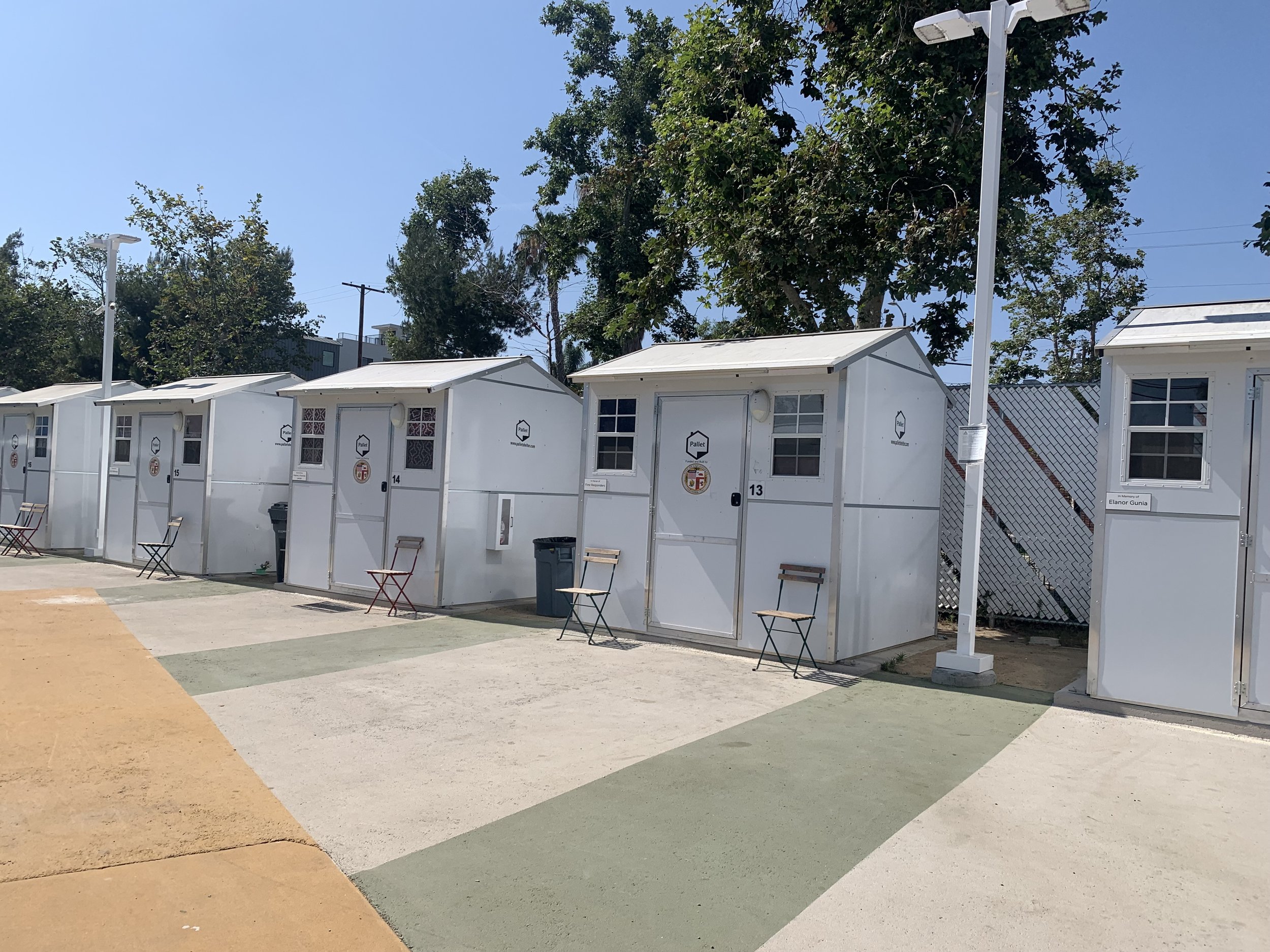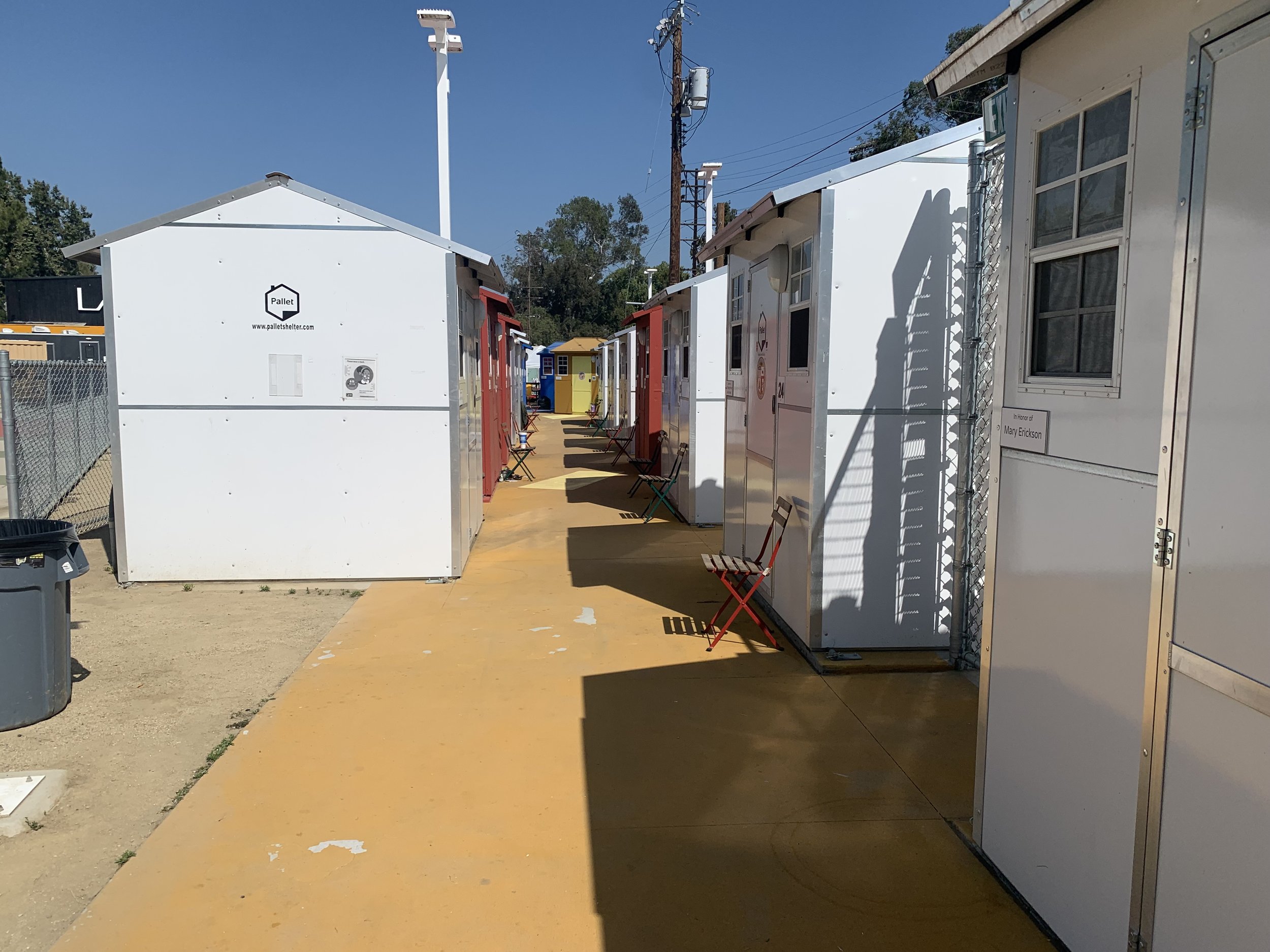Tiny Homes Provide Big Comfort for Los Angeles Homeless Population
The Chandler Blvd. Tiny Home Village in North Hollywood provides shelter and a place of healing for people without housing in the city of Los Angeles.
For one woman who was fleeing from a terrible situation, the Chandler Blvd. Tiny Home Village is a place of refuge.
“I landed here because I had an effing bad relationship behind me,” she said. “So I needed to have a place to have my quiet place, to be able to just relax my mind, and to just find jobs, and find out how I can get my own apartment. And just start again from zero.” The woman, who will be referred to as Jane, asked not to use her real name for her safety.
Hope of the Valley is a partially government funded, partially independently funded non-profit organization that aims to solve the homelessness crisis in Los Angeles. The organization is known for a specific kind of homeless shelter known as tiny home villages.
A tiny home village is exactly what it sounds like. It is a compound containing a series of many 64-square-foot homes. Each of these homes contains two beds, two windows, heat and air-conditioning systems and some storage space. Each tiny home houses two people. The organization has six tiny home village locations, with three shelters in North Hollywood, two in the San Fernando Valley, and one in Highland Park.
At Chandler Blvd., neat rows of white tiny homes line the walls of the compound. A few homes are colorful, and some residents even decorated their tiny homes to add their own personal touch. One resident hung up signs on her home with information and slogans for causes she supports. Another decorated the outside walls with flower stickers.
The organization provides the residents with three hot meals a day in a small outdoor dining area, with coffee available at all hours. There is a laundry area with multiple washers and dryers, five bathrooms with showers, one of which accessible to people with disabilities, and even a small library. There is also an area with garbage bins where the residents store their belongings, and there are two garbage bins per tiny home, which contain 60 gallons of space for each resident.
Kylene Wolfstein, the project manager at the Chandler Blvd. Tiny Home Village, said that the organization constructs tiny homes to be both comfortable and space-efficient. However, she said sometimes it’s not the physical space that matters the most.
“People experiencing homelessness, it’s hard, there’s a lot of trauma in that,” Wolfstein said. “So, we can only do so much for them to be comfortable, because a lot of it is just healing. It’s not necessarily, you know, having a shelf.”
Wolfstein also pointed out that each tiny home has a chair placed in front of it.
“It helps with the communal feel,” she said. “Like in the evening, between dusk, between nighttime and daylight, you’ll see more people chilling, maybe two or three people chilling here, just kind of talking to each other, and enjoying the weather.”
Wolfstein also shared a story about one man who found refuge through the organization. According to her, when the man came to the tiny home village, he was blind from cataracts, but after spending some time healing, he was able to see again.
“He went from walking with his cane, bumping into things, so now he’s like, ‘oh, I like your blue shirt,’” Wolfstein said.
For Jane, residing in the tiny home village after fleeing domestic abuse is what she needed after her harrowing experience.
“The biggest, greatest thing here is that you can have your quiet place to pacify and think about your future and be able to just focus and find out what is the right way for you,” she said. “And after so many traumas and problems, and mental issues that you had, you know, I appreciate that every day.”
Jane is now able to focus on her studies at her community college, where she studies English, drama, photography, and social media marketing.
She said that she would tell anyone in her position that “this is the best opportunity that you can have in your life, right? Just grab it and start again.”
Damon DeLillo, an independent contractor who works with the organization in development and fundraising, said that these tiny home villages are what is being termed “bridge housing.”
“Bridge housing is basically a bridge between the streets and permanent housing, so these bridge housing are kind of like transitional housing” he said. “And then hopefully, within about a six or 12-month period, we’ve not only dealt with a lot of the issues that may have put them on the street to begin with, but then we also provide permanent housing for them, and hopefully they don’t end up back on the street after that.”
DeLillo said that people experiencing homelessness can join the program and get housed in a tiny home by two main points of entry.
One point of entry is outreach teams. He said that the organization operates its own outreach team, but also coordinates with other organizations, neighborhood councils, and the Los Angeles Police Department to “touch base, communicate, and talk to anybody that they see on the street.”
“They go specifically to the encampments, to the underpasses, to the places where people are living on the streets, and basically encourage them, to basically let them know all of the resources available to them,” he said.
Another point of entry is access centers. DeLillo said they are places where a person can find bathrooms, meals, clothing, and storage for some of their personal belongings. Two of these access centers are located on Tyrone Ave. in North Hollywood, and Sherman Way in Van Nuys. He said that the only criteria for individuals that want to join the program is a “willingness or desire to get off the street and change their lives.”
He also said that once a person enters the organization’s shelters, they are assigned a case manager and housing navigator, and a mental health counselor if they have any mental health issues.
“What we do is provide what is being termed ‘wrap around’ services, so rather than sending a person out, all of the accounting of the things that they need to get back on their feet, we provide it in that environment,” he said.
He explained that the organization is able to do this because they coordinate with many other non-profits to provide all the services they possibly can.
“We have a lot of different non-profit organizations that we work with that provide all kinds of different services. So even though we only employ 500 people directly, there’s probably five times that many people that we actually are working with,” DeLillo said.
He provided an example of one organization that specifically deals with animal supplies and vet care.
“A lot of people who are on the street, who have a dog or a cat, or sometimes a reptile or a guinea pig, or a parrot, or whatever, you know when everything’s been taken away from them, this may be the only companionship they have, and they’ll opt to keep their animal than to enter a shelter,” he said.
DeLillo said that working with this specific organization has allowed the Hope of the Valley shelters to be some of the only shelters that allow people to keep pets. He shared some of the struggles of relying on government funding to run a human services organization.
“Even though the federal government may spend 400 percent on building a missile, when it comes to human services, they’ll fund maybe 80 percent and expect the other funding to come from other sources,” he said.
DeLillo also shared some of the limitations to the organization’s ability to get people off the streets for good. He said that of all the homeless shelters that the organization runs, “when we’re looking back and pulling all the numbers from all these different environments, in a six month or 12 month period, about 20 percent of the people that are in these environments end up in permanent housing.”
“But one of the things that people don’t see, and what doesn’t fall into that number, because that number is a number that we report on to the city, so it has a very narrow definition, these are people that have come into the program that our housing navigator actually placed into permanent or supportive housing,” he said. “It doesn’t include people who resolve in other ways.”
He said that for people who are living on the street, “it’s almost impossible to do anything except figure out where you’re going to eat today, where you’re going to sleep tonight. And you go into such a level of survival that it’s just impossible to do anything for tomorrow or the next day or the next week.”
He explained that is why many people in the organization’s shelters resolve their housing problem in this unofficial way.
“Often what happens, once we stabilize somebody in a shelter environment, help them with some of the things that they need, they’re no longer having to worry about ‘where am I going to find food today?’ or ‘am I going to have a place to sleep tonight? They can then focus on things like getting a job,” he said.
But DeLillo said sometimes the organization does not know how many people who benefit from the organization’s services fit into this category. He also explained that there are some unfortunate limitations to the organization’s capability to help people who are experiencing very severe problems.
“The sad part of the homeless reality especially in the state of California, is that there is a segment of the population, that there’s a lot of different names for it, whether you want to call it chronically homeless, or people that have severe mental health issues, or substance abuse issues,” he said. “And in some cases, there really isn’t an answer right now for various people.”
He said that there is a segment of people that are a part of their programs who are at “various stages of mental illness, substance abuse, who typically may get help, some of them may get help in a bridge housing situation, but often times they need 24-hour companionship and there is nothing that really provides that.”
DeLillo also stressed that people who struggle with homelessness are a diverse group of people and that every person’s circumstances are unique. He said there are multiple reasons why a person can be homeless, from the single mom fleeing domestic violence, to the teenager who just came out to their parents and was kicked out.
“The people that you’re actually seeing sleeping out on the sidewalks and that sort of thing, that is that kind of 5 or 10 percent that’s very visible. But you don’t often see the single moms, the teenagers, the kids, and the elderly,” he said.
For Jane, who was fleeing from a terrible situation and trying to start again, the Chandler Blvd. Tiny Homes Village has given her that chance.
“Being around the people who want to help you, who want to give you positive energy, who want to see, who want to see you go forward in your life. That’s very exciting,” she said. “It’s a beautiful place, with beautiful people, with beautiful hearts.”
Updated on August 7 for the correction of one tiny home village location. In an earlier version, the location was listed as Pasadena, but has been corrected to Highland Park. We regret the error.









